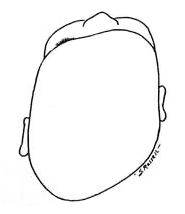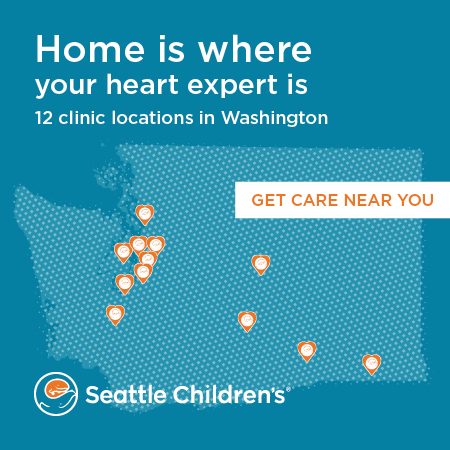Positional Plagiocephaly
What is positional plagiocephaly?
 Top of head of child with positional plagiocephaly (drawn by Huang MHS)
Top of head of child with positional plagiocephaly (drawn by Huang MHS)
Plagiocephaly (PLAY-gee-oh-SEF-uh-lee) is a flat spot on the back or side of a baby’s head.
It is caused by pressure on the bones of the skull before or after birth. This usually happens because of the way a baby likes to lie in their first few months of life.
By itself, a flat spot on a young baby’s head is generally not a concern. Your child’s doctor or nurse practitioner will check to see if there is a problem.
The condition also is called deformational plagiocephaly.
What causes positional plagiocephaly?
Many things can increase the chance of positional plagiocephaly:
- Many medical problems or delayed development. These may make it harder for a baby to change positions.
- A baby tending to look in 1 direction. If a baby’s neck muscles become too tight on 1 side, it can limit how much they can move their neck. This is called torticollis. It can cause the baby to always rest on the same spot on the back of their head.
- Premature birth. The skull bones of premature babies are softer than the skulls of babies born at full term. They also tend to move their heads less often.
- Being crowded in the womb. Crowding may happen if there is more than 1 baby in the womb (as in twins). Sometimes it happens if the mother has a womb with an unusual shape or has uterine fibroids (noncancerous tumors made of fibrous tissue).
Seattle Children's Craniofacial Center
Symptoms of Positional Plagiocephaly
Positional plagiocephaly can look different depending on which part of the skull has a flat spot. It can be very mild and hard to see, or it can be very easy to see.
- Often only the back of a baby’s head has a flat spot.
- Sometimes the forehead or face is also uneven.
- Usually the flatness is more on 1 side than the other (asymmetric). This is because babies like to rest on one side more than the other.
- Sometimes the flatness only affects the middle of the back of the head (symmetric). That happens if a baby always lies without turning their head.
Flat spots in a young baby’s head are common and do not always mean there is a problem. Your child’s doctor or nurse practitioner will check to see if your baby needs treatment.
Diagnosing Positional Plagiocephaly
To diagnose this condition, your child’s doctor or nurse practitioner will check your child’s head for features like:
- Bony ridges
- Flat areas
- Uneven forehead
- Two sides of the face that do not match each other (asymmetry)
- Ears that look different from each other
Your child’s healthcare provider will also check your child’s development. Some children with this condition have mild developmental delays. Read about Seattle Children’s research into the link between delayed development and positional plagiocephaly.
Positional plagiocephaly can sometimes look like a condition called craniosynostosis. These conditions need very different kinds of treatment. Our team is experienced in looking for the signs that help us tell these conditions apart.
Treating Positional Plagiocephaly
Treatment depends on the cause, your child’s age and how much their skull is affected.
- If muscle tightness limits your baby’s movement in the neck (torticollis), our team may recommend exercises or refer you to a physical therapist (PT).
- If lying in the same position is the cause and your baby is 5 months or less, the most important treatment is to change the position of their head when they lie down. Our team will help you learn to keep your baby off the flat portion of their head as much as possible. It is still important to put babies to sleep on their backs to lower the risk of sudden infant death syndrome (SIDS).
- If changing your baby’s position does not reduce the flatness and your baby is 6 months or older, a special helmet may help fix your baby’s uneven head shape.
Helmet therapy
If positional plagiocephaly is moderate or severe, your healthcare team will talk to you about whether helmet therapy is right for your baby.
At Seattle Children’s, we use the Starband helmet. It fits snugly on the round parts of your baby’s head but is looser on the flat parts. This gives the flat parts more room to expand as your baby’s head grows.
Your baby wears the helmet 23 hours each day. How long treatment lasts depends on your baby’s age and how severe the flatness is. Often children wear the helmet for 4 to 5 months.
Preventing Plagiocephaly
To prevent problems with plagiocephaly:
- Always place your baby to sleep on their back. This is the safest way.
- When your baby is awake, find ways for them to play and move while on their tummy. Do this several times each day.
- Choose different positions and ways for your baby to play and be held. Variety is important.
- Give your baby a lot of time sitting in laps and cuddling. When they are awake, avoid long periods lying on their back or strapped into infant seats or car seats.
- Encourage crawling, rolling, reaching, pushing, pulling, holding and grasping.
It is OK to use strollers, car seats, infant seats, bassinets, cribs and play pens when necessary. But remember that babies need chances to move that do not happen while sitting in only one position.
Research to Improve Care
We receive more research funding from the National Institutes of Health (NIH) than any other craniofacial center in the United States.
Our researchers are studying development in children with positional plagiocephaly compared to children without it.
Earlier studies by Seattle Children’s found developmental delays in infants, toddlers and preschoolers with positional plagiocephaly compared to children without positional plagiocephaly.
As the study continues, our researchers will measure the children’s development at 8 years. Researchers want to know if children with better motor skills (like walking and running) also have better cognitive (brain) development.
The findings do not show that plagiocephaly causes developmental delays. In fact, it may be the opposite. Researchers think the condition may be a “marker” that could identify if a child is at risk for delayed development. They recommend that all babies with flattened skulls be screened for developmental problems.
Positional Plagiocephaly at Seattle Children’s
Specialists in our Craniofacial Center see and treat children with positional plagiocephaly. We also do research to better understand the condition and improve treatments.
-
Your child is in the hands of experts
In the past 5 years, we have cared for more than 4,400 babies with this condition. Because of our experience, we can recommend the right treatment at the right time to have the best results for your child and your family. We will create a personalized plan of care for your child.
We have experience with many treatments for this condition. These include:
- Exercises to increase the flexibility of your baby’s neck
- Helping you position your baby to reduce flat spots
- Using special helmets to reshape the head
-
We support your whole family
It can be scary when your baby has a condition that affects their skull. We take time to explain your child’s condition. We help you fully understand your treatment options and make the choices that are right for your family.
A nurse practitioner will work closely with your family to manage care and make sure all your questions are answered. If your child needs helmet therapy, an orthotist will design the helmet and make sure it fits. Other experts will join your team depending on your child’s needs.
Seattle Children’s provides craniofacial (face and skull) care for children in the Seattle area and far beyond. A nurse practitioner experienced with this condition holds a clinic in the Tri-Cities each month.
Families who do not live in the Seattle area may use an orthotist in their local area to make and fit a helmet. We can provide a referral for your baby if needed.
Contact Us
Contact the Craniofacial Center at 206-987-2208 for an appointment, a second opinion or more information.
Providers, see how to refer a patient.

